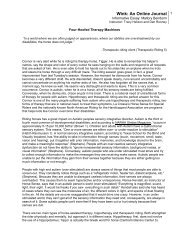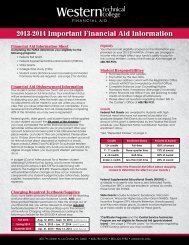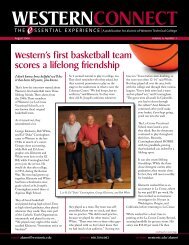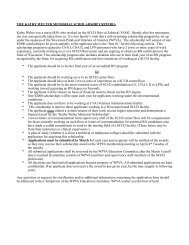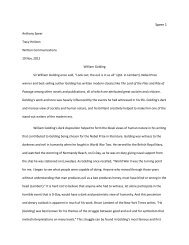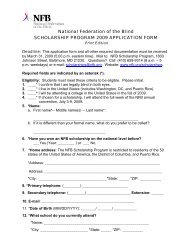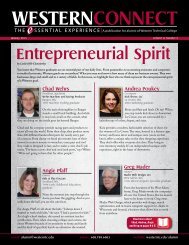The History of Western Technical College
The History of Western Technical College
The History of Western Technical College
You also want an ePaper? Increase the reach of your titles
YUMPU automatically turns print PDFs into web optimized ePapers that Google loves.
Employment Service, La Crosse Chamber <strong>of</strong> Commerce and Junior Chamber <strong>of</strong> Commerce and the U. S. Department <strong>of</strong><br />
Labor gathered to honor the graduates. <strong>The</strong> apprentices who spent from four to five years learning their crafts under<br />
highly skilled specialists were in the bricklayers, carpenters, painters, electricians, plumbers, steamfitters, plasterers and<br />
glaziers trades. A La Crosse Tribune editorial commented, “La Crosse labor unions are making a distinct contribution to<br />
craftsmanship in various trades . . . the ceremonies in effect become graduation exercises for men in the various<br />
crafts–recognition that they have completed established training and thus are equipped with basic knowledge <strong>of</strong> the<br />
principles <strong>of</strong> the trade.”<br />
Polio victims Dorance Gibbs <strong>of</strong> La Crosse and Gerald Williams <strong>of</strong> La Crescent . . . their teachers were unanimous in their<br />
agreement that the two are good students. Statements by their teachers Marie Peterson, Genevieve Cox and Wesley<br />
Ballsrud concluded “they are normal people in their work . . . their only handicap is in getting about as easily as some <strong>of</strong><br />
the other students.”<br />
Yttrie Brothers. Three brothers enrolled in auto mechanics at the same school – and, at the same time. Formerly <strong>of</strong><br />
Viroqua, the trio is Merlin, Harlan and Gerald.<br />
In 1949, the Auditorium was used 110 times by civic organizations requiring janitorial, maintenance and other services.<br />
Some <strong>of</strong> the 1949 Auditorium events included . . .<br />
January 16 <strong>The</strong> Vocational Civic Choir <strong>of</strong> 80+ voices presented the oratorio “Elijah” by<br />
Felix-Mendelssohn-Bartholdy, under the direction <strong>of</strong> C. Bernard McGhee<br />
March 13<br />
<strong>The</strong> Vocational Civic Band gave its annual concert under the direction <strong>of</strong> Frank Italiano. Concluding<br />
selection was the spectacular Tschaikowsky “1812 Overture”. “<strong>The</strong> climax <strong>of</strong> a full 75-piece band,<br />
augmented by organ, fairly rocked the rafters and brought round after round <strong>of</strong> applause.” First <strong>of</strong><br />
a kind in this area was the Coulee Region musicianship audition. <strong>The</strong> judges had their backs to the<br />
participants so that they would be influenced by no qualities except those <strong>of</strong> musicianship<br />
April 25 <strong>The</strong> Vocational Civic Choir, under the direction <strong>of</strong> C. Bernard McGhee, presented a varied program<br />
with two local artists as guest soloists (Ruth Kienholz and Mary Simones) with selections from Bach,<br />
Haydn, and others. Among the folk songs that were performed was “Ezekiel Saw De Wheel.”<br />
November 29 <strong>The</strong> La Crosse Symphony Orchestra presented a concert with Leigh Elder as the director. <strong>The</strong><br />
Singing Kappels, a husband and wife vocal team <strong>of</strong> Shorewood, Wisconsin augmented the program.<br />
Music ranged from the classics to the tunes <strong>of</strong> Sigmund Romberg.<br />
December 10-11 <strong>The</strong> Old Style quartet was one <strong>of</strong> the four local barbershop quartets featured at the Christmas<br />
Festival <strong>of</strong> Song sponsored by the La Crosse SPEBSQSA chapter. Three other local quartets also<br />
appeared. <strong>The</strong>y were the Four Hoarsemen, the Nameless Four, and Casey’s Four-Wheelers.<br />
Guest quartets on the program also included the Milwaukee Hi-Los; and the Minneapolis-Moline<br />
Atomic Bums.<br />
<strong>The</strong> 1950’s<br />
<strong>The</strong> 1950’s were years <strong>of</strong> progress in program development, program standards, and a strict program approval process.<br />
While vocational education struggled to survive at the federal level, it grew and took shape in Wisconsin. It was a time<br />
when educators and supporters had to join forces and work hard to save vocational education. <strong>The</strong> 1950’s saw great<br />
technological and social changes. It was the era <strong>of</strong> Sputnik, first generation computers, TV dinners, the Salk vaccine for<br />
polio, and rock and roll. <strong>The</strong> changes were also reflected in the vocational and adult system. Thousands <strong>of</strong> veterans<br />
enrolled either to finish high school or for vocational training. <strong>The</strong> 50’s also saw the introduction <strong>of</strong> the technical<br />
program, which would lead to an associate degree. <strong>The</strong> two-year associate degree was a response to the increasingly<br />
sophisticated labor market, which needed workers with training that was more rigorous than the traditional vocational<br />
program, and yet, more practically oriented than a four-year degree. <strong>The</strong> first technical programs were approved in<br />
1956 in electronics, auto technology and mechanical technology.<br />
1950 Board members were: George Hall, president; Raymond Bice, vice president; Superintendent <strong>of</strong> School Marshall<br />
Batho, secretary; Roy Kumm, and R. H. Anderegg.<br />
Open House – February 13-14, 1950 – while Old Man Winter blew inches <strong>of</strong> snow into the Coulee Region, the doors <strong>of</strong><br />
the Vocational School were swung open for the public to view exhibits and partially finished projects,





